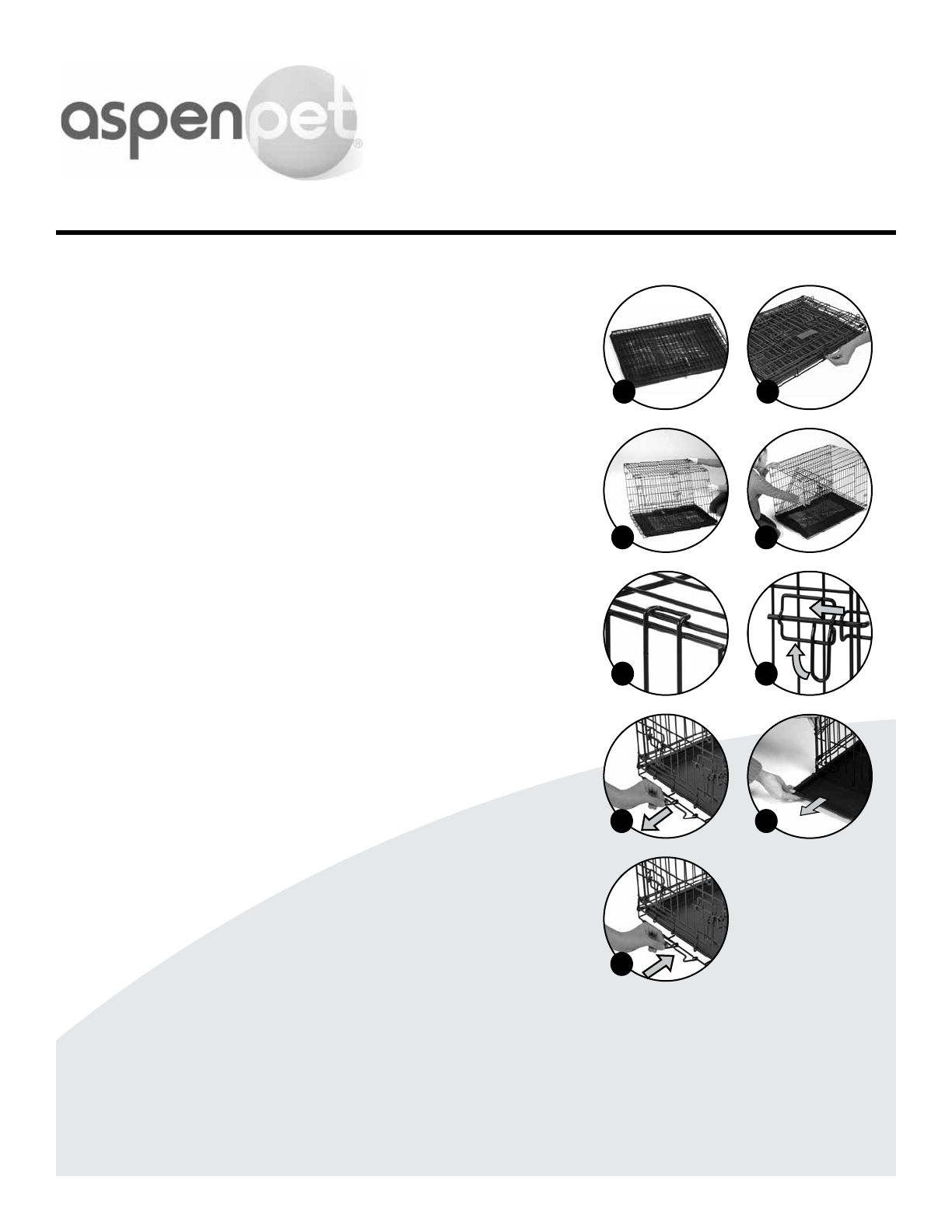
A1 A2
A3 A4
A5 A6
B3
B1 B2
READ AND FOLLOW ALL INSTRUCTIONS AND
WARNINGS THAT COME WITH THIS KENNEL.
To assemble kennel:
A1. Wire kennel comes collapsed, in locked position with plastic pan installed.
Lay kennel at on any non-scuff surface and locate lock wire. Lock wire
should be pointing up for proper assembly position.
A2. Unlock wire kennel by pulling lock wire down. Fold out top kennel panel.
A3. Grab overhanging panel, lift up and swing over to form main structure
of kennel.
A4. Reach in and pull up door panel. Door panel has 4 side wall latches and
two top panel corner locks. Make sure all are secured.
A5. Once complete, engage top panel center latch over top side of kennel.
Follow same procedure to secure back panel of kennel.
A6. Open door by raising latch mechanism all the way up and pushing over.
Always make sure door is properly secured when animal is inside.
To remove plastic pan:
B1. Lift front door panel up so that pan-locking device can slide under the front
door panel.
B2. Slide pan out from front of kennel.
B3. Reverse steps to reengage pan-locking device.
Note: Do not let pet inside kennel without pan-locking device engaged.
WARNING: Do not let animal in kennel without pan in place. Do not try to
remove pan any other way, for risk of damaging or breaking of pan. Do not let
pet inside kennel with a broken pan. Be sure pan-locking device is engaged
while pet is inside kennel. Do not remove/replace tray while animal is inside.
For information on ordering a replacement pan, go to petmate.com or
call 1-877-738-6283.
Doskocil Manufacturing Company, Inc. d/b/a Petmate
PO Box 1246, Arlington, TX 76004-1246
1-877-738-6283
© Doskocil Manufacturing Company, Inc. d/b/a Petmate 2011
pet home
training kennel
™
instructions
CAUTIONS
Kennels are engineered to hold pets safely and securely under normal use for many years of service. Used properly, kennels are an
invaluable tool for training and safe travel. Please observe the following cautions and guidelines.
READ AND FOLLOW ALL INSTRUCTIONS ACCOMPANYING THIS KENNEL BEFORE USING IT.
• This kennel is not designed to restrain aggressive breeds of dogs.
• Never use a kennel as a method of punishment.
• Improper use of this kennel may result in serious injury or even the death of your pet.
• To avoid choking and other serious injuries, remove all collars, harnesses and other items, such as pet clothing, before placing the
pet in the kennel.
• Pets should not be left unattended in the kennel until and unless you are certain that the pet will respond properly to being left alone
in the kennel.
• Among other things, a pet not specically trained to be contained in the kennel may attempt to escape, dig and/or chew out of the
kennel, causing serious harm or death to the pet.
• Make sure all corner locks and side wall latches are engaged and secured before leaving pet inside kennel.
• Consult your veterinarian or trainer to determine an appropriate training method and length of time your pet can safely be left
in the kennel.
• Pet should have access to food and water at all times while in kennel.
• Do not place any other items, such as toys, in the kennel with your pet unless your veterinarian or trainer advises you that it is safe
to do so.
• Do not place more than one pet in the kennel at a time.
• We are not responsible for any loss caused by improper use of this product or for use of this kennel by a pet that has not been
properly trained.
• Do not use kennel without its plastic pan.
• Do not use kennel with a broken plastic pan. For information on ordering a replacement plastic pan, go to petmate.com or
call 1-877-738-6283.
• Do not let pet inside kennel without plastic pan-locking device engaged.
• Do not use kennels in place of outdoor runs or long term holding cages. Young animals should be allowed out of their kennel well
before the limits of their bladder and bowel control will tolerate. Many adult animals will tolerate kenneling during half a normal
workday.
• Do not allow children to play in, on or around the kennel. Keep kennel door closed around children to avoid the hazard of protruding
hinge and latch pins.
• Periodically inspect the plastic shell for cracks, especially after exposing the kennel to severe shocks, changes in temperature or
other harsh and challenging conditions.
• If any structural component is discovered to be broken or is missing, stop use of kennel immediately.
• Do not attempt to make any repairs or modications to this kennel. Doing so will void warranty.
• Biting, chewing, licking, ramming or pawing at either the plastic shell or metal wire parts may result in injury to the pet or damage to
the kennel. These are excluded under the product’s warranty.
• Exercise caution when closing and opening the kennel door to avoid catching pet’s paws, tail or snout in mechanism.
• Avoid heat injury or death: never leave pets in a closed car on a hot day or in direct sun. Car windows have a greenhouse effect
and temperatures can rise to well over 100 degrees inside a closed car within minutes! Similarly, never leave a pet unattended in its
kennel in direct sunlight.
• Kennel should be cleaned routinely for the hygiene of the pet.
Contact us toll free within the U.S. at 1-877-738-6283 with questions about proper kennel training, product use, warranty
or replacement parts.
